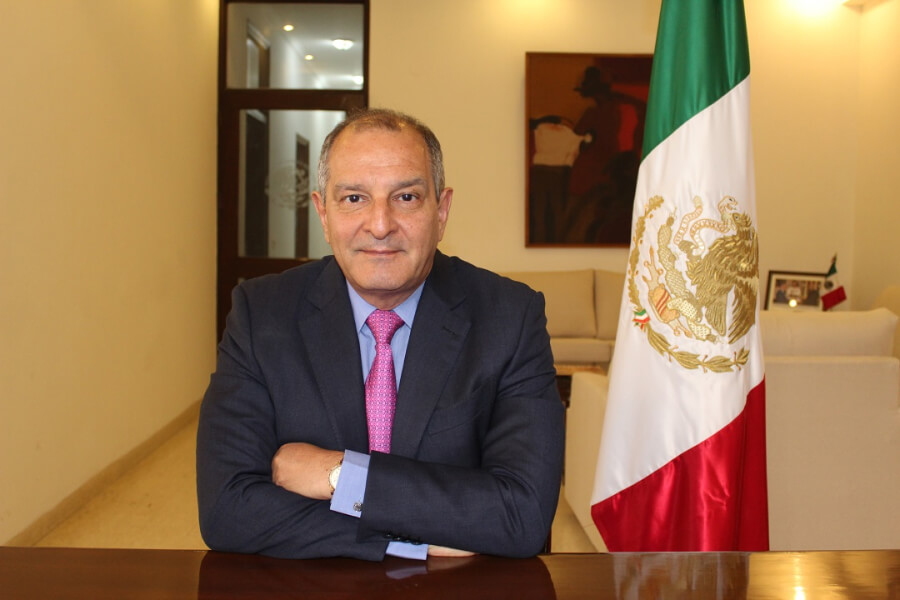India and Mexico have the dynamics for a strategic relationship
H.E. Federico Salas Lotfe, Ambassador of Mexico to India, emphasises the strong complementarities and similar economic dynamism that are driving greater India-Mexico trade relations, which have already gained momentum during the pandemic and have a wide perspective ahead.
He also discusses how Mexico, as India’s largest trade partner in Latin America, is importing more Indian goods than Canada, Russia, Sri Lanka, Israel or Spain. As the first investor from the region, Mexico is vital to enhance India’s footprint in the Pacific.

India and Latin America represent an increasingly critical bilateral partnership, which is, quite interestingly, strongly hinged on economic complementarities that transcend the barriers of distance. However, within the region, Mexico has a unique position as a partner with the US and Canada in the new FTA – USMCA – that took over the NAFTA in 2020. Over the past few years, Mexico has become India’s largest trading partner in Latin America, and the second largest in the Americas after the United States.
Indeed, Mexico has become the de facto entrance of India to the LAC region, besides Canada and the US, while giving its investors privileged access to 46 other countries that form part of its network of FTAs.
In this direction, Mexico is also a pivotal partner for India in multilateral fora, with common views on COVID-19 vaccine access and recognition in United Nations and the G20. It is also a like-minded partner in the World Trade Organization for a temporary global waiver on patent protection for COVID-19 vaccines, which was proposed by India and South Africa.
The total volume of India-Mexico trade in 2018 hit US$ 10 billion. Though the pandemic brought down those numbers to US$ 7 billion for the fiscal year 2020-21, trade between India and Mexico was a third of the total trade of India with the rest of LAC. While the investments of Mexican business in India peaked at US$ 610 million, with the recent investment of Bimbo in the bakery sector, in early 2021.
A stronger platform can be built with the conclusion of the new investment agreement, to move forward and revive the momentum, so that the economic relationship can continue to flourish, not only in terms of numbers, but also the array of products and business being exchanged between India and Mexico.
A tale of two dynamic economies
Mexico is the 15th largest economy in the world, the 12th largest exporter globally, the second largest economy in Latin America, and the first trade partner of the US. Before the pandemic, Mexico was India’s largest trading partner in Latin America and it has increased its position as the main market for Indian goods, while its main exports to India are crude oil, strategic for India’s development.
On the other hand, India was also among the top 10 trading partners of Mexico on a global level. So the importance of bilateral trade had reached a very significant level and the same is true of the level of investments taking place in both directions.
Almost a third of the trade between Latin America and India equals to the trade among India and Mexico. It accounts for 23% of total Latin American exports to India and more than 30% of the Indian exports to Latin America – considered as a region separate from Mexico by the Ministry of Commerce & Industry of India, since it includes Mexico in North America.
Mexico’s economic structure has changed quite dramatically. In the 1980s and early 1990s, about 70% of our exports were oil. Today only about 5% of the exports of Mexico are oil-related, which emphasises an economic diversification that is very important.
Let us look at some indicators pertaining to Mexico’s standing on the global stage:
- Seventh largest manufacturer and fourth largest exporter of vehicles in the world.
- Fourth largest producer and largest global exporter of beer.
- Largest exporter of flat screens and refrigerators.
- Sixth largest global supplier of the aerospace industry.
- Mexico is the seventh largest producer of food products in the world.
Mexico currently has a population of 126 million people, which is one tenth of the population of India. But it’s very important to mention here that the broad arrangement of free trade agreements (FTAs) with 46 countries, and the total number of people covered by the reach of those agreements is almost equivalent to the population of India of 1.3 billion people.
About 50% of Mexico’s population is under 29 years of age, many getting involved in tech studies and jobs, which is very similar to the demographic profile in India. Just like India, Mexico has a dynamic workforce with a growing market. This also speaks volumes for the success that more than 80 Indian companies have achieved so far in Mexico, and almost 200, if those linked to the US and Canada are considered. These companies have made investments and established physical presence in Mexico, thereby achieving success in a broad range of fields like pharma, fertilizers, hi-tech, automobiles, and steel.
The bulk of Mexico’s exports to India today are constituted by oil. The two countries are already working on the automobile sector, with a lot of complementary trade going back and forth especially now, with the possibility of moving into electrical vehicle manufacturing and broad opportunities in aerospace. The pharmaceutical sector is also growing strongly from India to Mexico, with 20 main industries already settled, and an opening market for vaccines and generics, due to the increased awareness in Mexico and the pandemic itself. So, there is potential to continue to grow and deepen the economic and trade relationship between the two countries.













Leave a comment